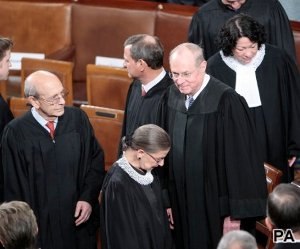Chief Justice John Roberts is, surprisingly, the least divisive Justice on the Supreme Court, but perception of other Justices is highly partisan
Last week, the Supreme Court took center stage with a series of high profile decisions on the Voting Rights Act, gay marriage and affirmative action. Each of the decisions was a matter of intense political contention and while the Supreme Court is ostensibly a non-partisan body, new YouGov research illustrates how partisan the perception of each of the Supreme Court Justices is.
Across the general population, favorability of each individual Justice is more or less split, with most having the number of supporters and detractors differ only by a few percentage points. Elena Kagan is the worst perceived with 18% of Americans having a favorable opinion and 28% having a negative opinion.
Among those affiliated with political parties, opinion is far from split, however. The Justices most favored by Democrats are Sonia Sotomayor (42% net approval) and Ruth Bader Ginsberg (35% net approval). The worst perceived are Clarence Thomas (-28% net approval) and Scalia (-18% net approval).
For Republicans, the best perceived Justices are Thomas (35% net approval) and Scalia (22% net approval), while the worst perceived are Kagan (-50% net approval) and Sotomayor (-49% net approval).
There is also a subtle difference between Republicans and Democrats in terms of perception, with Democrats tending to have more favorable opinions of any individual Justice and Republicans tending to have more negative opinions of any single Justice.
While Republicans and Democrats do not agree in their assessment of any specific Justice, there were some Justices for which opinion diverged less than others. The two Justices for which there is the least divergence are John Roberts and Anthony Kennedy. Roberts is viewed better by Republicans and Kennedy is viewed better by Democrats, however the margin between Republican and Democratic support for both is much smaller than for the other Justices.
While being in the middle is expected for Anthony Kennedy, who has long been considered the swing vote on the court, this is slightly more surprising for John Roberts, who was initially considered a stalwart conservative. However, with his support for what was considered the liberal side in cases such as the Affordable Care Act, his reputation has shifted somewhat. In fact, in 2012, shortly after the decision on the Affordable Care Act, Roberts was better perceived among Democrats than Republicans.
Overall, partisan perceptions of the Justices are firmly in line with their established ideological roles on the court, with conservative Justices doing well with Republicans and liberal ones doing well with Democrats.









